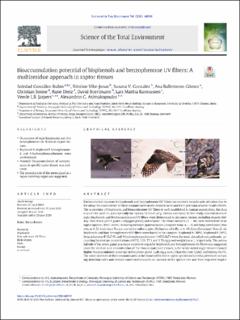| dc.contributor.author | Rubio, Soledad González | |
| dc.contributor.author | Vike-Jonas, Kristine | |
| dc.contributor.author | Gonzalez, Susana V. | |
| dc.contributor.author | Ballesteros-Gómez, Ana | |
| dc.contributor.author | Sonne, Christian | |
| dc.contributor.author | Dietz, Rune | |
| dc.contributor.author | Boertmann, David | |
| dc.contributor.author | Rasmussen, Lars Maltha | |
| dc.contributor.author | Jaspers, Veerle | |
| dc.contributor.author | Asimakopoulos, Alexandros | |
| dc.date.accessioned | 2021-01-25T13:33:25Z | |
| dc.date.available | 2021-01-25T13:33:25Z | |
| dc.date.created | 2020-12-15T13:48:12Z | |
| dc.date.issued | 2020 | |
| dc.identifier.citation | Science of the Total Environment. 2020, 741, . | en_US |
| dc.identifier.issn | 0048-9697 | |
| dc.identifier.uri | https://hdl.handle.net/11250/2724583 | |
| dc.description.abstract | Environmental exposure to bisphenols and benzophenone UV filters has received considerable attention due to the ubiquitous occurrence of these contaminants in the environment and their potential adverse health effects. The occurrence of bisphenols and benzophenone UV filters is well established in human populations, but data is scarce for wildlife, and especially for raptors (birds of prey, falcons and owls). In this study, concentrations of eight bisphenols and five benzophenone UV filters were determined in six raptor tissues, including muscle, kidney, liver, brain, preen gland (uropygial gland) and adipose. The tissue samples (n = 44) were taken from dead raptor species (1997–2011), including Eurasian sparrowhawks (Accipiter nisus, n = 2) and long-eared owls (Asio otus, n = 2), both from France, and white-tailed eagles (Haliaeetus albicilla, n = 16) from Greenland. Overall, six bisphenols and four benzophenone UV filters were found in the samples. Bisphenol A (BPA), bisphenol F (BPF), benzophenone-8 (BzP-8) and 4-hydroxybenzophenone (4-OH-BzP) were the most abundant contaminants, accounting for median concentrations of 67.5, 3.01, 27.1 and 9.70 ng/g wet weight (w.w.), respectively. The potential role of the preen gland as a major excretory organ for bisphenols and benzophenone UV filters was suggested since the median sum concentration of the two contaminant classes in the white-tailed eagle tissues showed higher bioaccumulation potential in the preen gland (5.86 ng/g w.w.) than the liver (2.92) and kidney (0.71). The concentrations of these contaminants in the tissues of the three raptor species indicated a pattern of increasing detection rates and median concentrations with an increase of the species size and their expected trophic position. To the best of our knowledge, this is the first peer-reviewed study to document multiresidues of both contaminant classes in raptor tissues. | en_US |
| dc.language.iso | eng | en_US |
| dc.publisher | Elsevier | en_US |
| dc.rights | Navngivelse 4.0 Internasjonal | * |
| dc.rights.uri | http://creativecommons.org/licenses/by/4.0/deed.no | * |
| dc.title | Bioaccumulation potential of bisphenols and benzophenone UV filters: A multiresidue approach in raptor tissues | en_US |
| dc.type | Peer reviewed | en_US |
| dc.type | Journal article | en_US |
| dc.description.version | publishedVersion | en_US |
| dc.source.volume | 741 | en_US |
| dc.source.journal | Science of the Total Environment | en_US |
| dc.identifier.doi | https://doi.org/10.1016/j.scitotenv.2020.140330 | |
| dc.identifier.cristin | 1860071 | |
| dc.description.localcode | This is an open access article distributed under the terms of the Creative Commons CC-BY license, which permits unrestricted use, distribution, and reproduction in any medium, provided the original work is properly cited. | en_US |
| dc.source.articlenumber | 140330 | en_US |
| cristin.ispublished | true | |
| cristin.fulltext | original | |
| cristin.qualitycode | 2 | |

